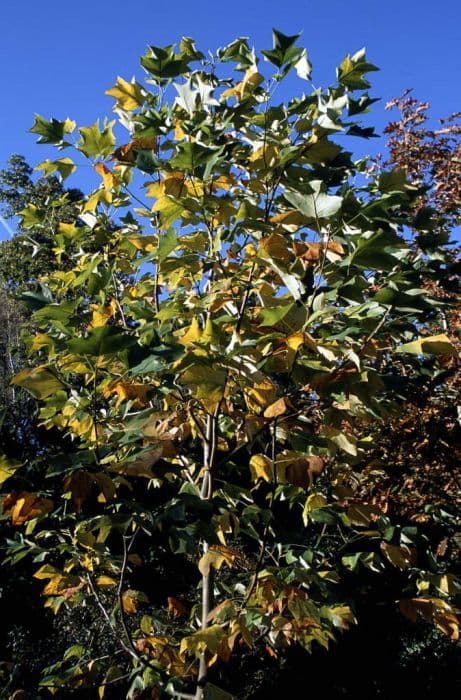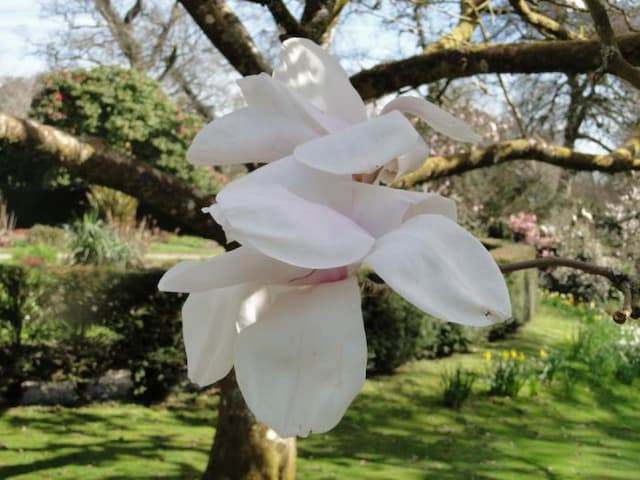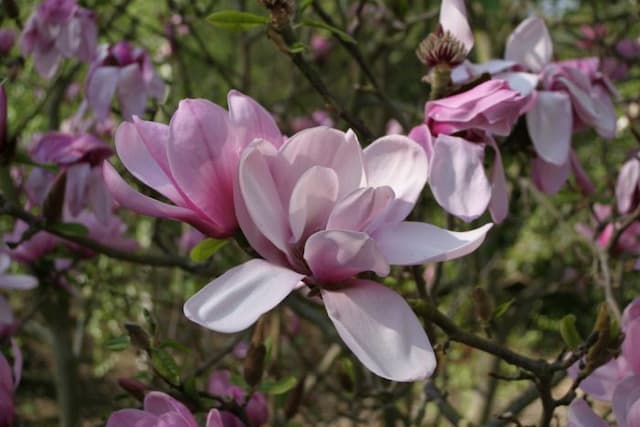Magnolia Magnolia 'Caerhays Belle'

ABOUT
The Magnolia 'Caerhays Belle' is a striking flowering plant known for its large, cup-shaped blooms that make a visual impact in the garden. The flowers are a radiant shade of pink, often described as a soft or pale pink, that can occasionally have a deeper tone towards the base, giving a subtle gradation of color. They are highly aromatic, releasing a sweet, heady perfume that can envelop the surrounding area. The petals of the Magnolia 'Caerhays Belle' are broad and rounded, with a lush, velvety texture that presents an inviting look. Often, the plant displays several petals that overlap slightly, giving the flowers a full and voluptuous appearance. At the center of each bloom, contrasting stamens may be visible, adding to the visual interest of the flower. The leaves of this Magnolia are glossy and leathery, emerging with a rusty hue before maturing to a deep green color. They form a backdrop to the flowers, creating a striking contrast that makes the floral display even more pronounced. The foliage arrangement provides a dense canopy of green throughout the growing season, offering a lush, verdant appearance that endures long after the flowering period. Overall, the Magnolia 'Caerhays Belle' is celebrated for its ornamental value, primarily due to its large, elegant flowers and attractive foliage that come together to create a magnificent spectacle in the landscape.
About this plant
 Names
NamesFamily
Magnoliaceae
Synonyms
Caerhays Belle Magnolia
Common names
Magnolia 'Caerhays Belle'.
 Toxicity
ToxicityTo humans
Magnolia 'Caerhays Belle', commonly referred to as Magnolia, is not widely known for its toxicity to humans. There is little to no information suggesting that the Magnolia plant is poisonous when ingested. Therefore, it generally does not cause symptoms of poisoning in humans. However, as with any non-food plant, it is advisable to err on the side of caution and avoid ingestion, as individual reactions to plants can vary.
To pets
Magnolia 'Caerhays Belle', simply known as Magnolia, is not considered highly toxic to pets. There is no substantial evidence that ingesting parts of the Magnolia plant causes significant poisoning symptoms in pets such as cats or dogs. However, gastrointestinal upset is a common reaction in animals when they ingest plant matter they are not accustomed to, so some mild digestive discomfort is possible.
 Characteristics
CharacteristicsLife cycle
Perennials
Foliage type
Deciduous
Color of leaves
Green
Flower color
Pink
Height
20 feet (6 meters)
Spread
10 feet (3 meters)
Plant type
Tree
Hardiness zones
7
Native area
Hybrid
Benefits
 General Benefits
General Benefits- Ornamental Value: Adds visual interest to gardens with its large, pink flowers and lush foliage.
- Year-Round Interest: Evergreen leaves provide greenery throughout the year, while the flowers offer a colorful display in spring.
- Wildlife Attraction: The blossoms are a nectar source for bees and other pollinating insects.
- Shade Provider: Its broad canopy can offer shade in garden landscapes or smaller yards.
- Privacy Screen: Can be utilized as a natural privacy screen or windbreak thanks to its dense growth habit.
- Aesthetic Versatility: Suitable for a variety of garden styles, including formal, cottage, and woodland gardens.
- Low Maintenance: Requires minimal pruning and is generally disease-resistant, making it easier to care for than some other ornamentals.
- Drought Tolerance: Once established, it can tolerate periods of dry weather, reducing the need for frequent watering.
- Fragrance: The flowers emit a delightful scent that can enhance the sensory experience of a garden.
- Cultural Significance: Recognized for its beauty, the Magnolia is often associated with nobility and perseverance.
 Medical Properties
Medical Properties- This plant is not used for medical purposes.
 Air-purifying Qualities
Air-purifying QualitiesThis plant is not specifically known for air purifying qualities.
 Other Uses
Other Uses- The dried and crushed leaves of the Magnolia tree can be used as a natural insect repellent, as some species contain compounds that repel pests.
- Magnolia petals and buds can be candied and used as a unique and decorative topping for desserts and cakes.
- The bark of the Magnolia tree, which is rich in tannins, can be used in the process of tanning leather to achieve a desirable color and texture.
- Wood from Magnolia trees is sometimes used in furniture making or woodworking due to its workability and smooth grain.
- Magnolia cones, which contain seeds, can be used in floral arrangements or as part of natural craft projects for texture and interest.
- The essential oils extracted from Magnolia flowers are used in perfumery for their sweet and citrusy fragrance notes.
- The large, sturdy leaves of the Magnolia tree are sometimes used as a natural wrapping material for cooking, similar to banana leaves in some cultures.
- Magnolia flower petals can be used as a natural fabric dye, giving textiles a soft green or yellow hue.
- The fibrous inner bark, or phloem, of the Magnolia tree can be processed to make ropes or woven into fabric for mats or bags.
- Thick Magnolia branches can be repurposed as natural garden stakes or supports for climbing plants in the garden.
Interesting Facts
 Feng Shui
Feng ShuiThe Magnolia is not used in Feng Shui practice.
 Zodiac Sign Compitability
Zodiac Sign CompitabilityThe Magnolia is not used in astrology practice.
 Plant Symbolism
Plant Symbolism- Nobility: Magnolias are often associated with nobility and dignity, due to their impressive and stately appearance.
- Perseverance: They are one of the first plants to bloom in spring, often braving cold weather, symbolizing perseverance and endurance.
- Femininity: The magnolia's large petals and graceful shape are often seen as a representation of feminine beauty and gentleness.
- Purity: The color and form of the magnolia flower are commonly associated with purity and innocence.
- Etiquette: In traditional Victorian symbolism, magnolias represented refinement and poise.
- Welcoming: The magnolia is sometimes seen as a symbol of hospitality, with the open nature of its blossoms indicating a welcoming environment.
 Water
WaterMagnolia 'Caerhays Belle', commonly known as Magnolia, should be watered deeply about once a week to maintain moist soil conditions, particularly during the growing season in spring and summer. The amount of water required can range from 1.5 to 2 gallons each watering, depending on the size of the plant and the weather conditions. It's important not to overwater, as standing water or waterlogged soil can lead to root rot. In the fall and winter when the plant is dormant, reduce watering frequency, but ensure the soil does not completely dry out.
 Light
LightMagnolia 'Caerhays Belle' thrives in full sun to partial shade, with a preference for a spot that receives morning sunlight and some afternoon shade, especially in hotter climates. Too much direct sun in the peak of summer can cause leaf scorch, while too little light can lead to sparse blooms and leggy growth. The ideal location offers protection from harsh afternoon sun while providing enough light for healthy growth and flowering.
 Temperature
TemperatureMagnolia 'Caerhays Belle' prefers moderate temperatures and will thrive in USDA hardiness zones 7 to 9. It can typically tolerate minimum temperatures around 0 to 10 degrees Fahrenheit, but growth will be best when temperatures hover between 60 and 75 degrees Fahrenheit. It's important to protect the plant from extreme cold by applying a thick layer of mulch or covering it during frost.
 Pruning
PruningPruning is used to shape Magnolia 'Caerhays Belle' and remove any dead or damaged branches, enhancing the plant's overall appearance and health. Light pruning should be performed after the blooming period has ended, usually in late spring or early summer. It is crucial not to over-prune, as this can limit blooming in the following season. Pruning once a year is typically sufficient for this magnolia.
 Cleaning
CleaningAs needed
 Soil
SoilFor the best soil mix for a Magnolia plant, including 'Caerhays Belle', use a nutrient-rich, well-draining loamy soil with a slightly acidic to neutral pH of 5.5 to 7.0. Blend in organic matter such as compost or peat moss to improve soil structure and nutrient content.
 Repotting
RepottingMagnolia 'Caerhays Belle' typically doesn't require frequent repotting. Repot young plants every 2-3 years and mature plants only when rootbound, which can be 5 years or longer apart, ensuring minimal root disturbance.
 Humidity & Misting
Humidity & MistingMagnolia 'Caerhays Belle' prefers moderate humidity levels but is adaptable to the average outdoor humidity. It benefits from extra humidity in dry climates but generally tolerates the natural humidity of most regions well.
 Suitable locations
Suitable locationsIndoor
Provide bright, indirect light and keep away from dry heat.
Outdoor
Choose a sunny spot with shelter from strong winds.
Hardiness zone
7-9 USDA
 Life cycle
Life cycleMagnolia 'Caerhays Belle' starts its life as a seed, which upon germination in the right conditions of warmth and moisture, develops a radicle that evolves into a root system and a shoot that grows upwards. As it grows, the shoot becomes a seedling with leaves that photosynthesize to fuel further growth. The seedling then matures into a young tree with a sturdy trunk and branches, during which it starts to develop flower buds that require a chilling period to initiate blooming. The mature tree blooms in early spring, usually before the leaves appear, producing large, pink, fragrant flowers that are pollinated by bees and other insects. After pollination, the flowers develop into cone-like fruit with seeds that, once mature, disperse to give rise to new plants. Finally, this plant reaches the end of its life cycle when it succumbs to environmental stresses, diseases, or old age, completing the life cycle from seed to senescence.
 Propogation
PropogationPropogation time
Spring
The most popular method of propagation for the Magnolia 'Caerhays Belle' is through semi-hardwood cuttings. This involves taking cuttings of the plant's current year's growth in late summer when the wood has begun to harden slightly but is not yet fully mature. The cuttings, typically about 4 to 6 inches (around 10 to 15 centimeters) in length, are taken with a sharp, clean cutting tool, and the leaves from the lower half of the stem are removed. The base of the cuttings is then dipped in rooting hormone to encourage root development and planted in a well-draining propagation medium such as a mixture of peat and perlite or sand. It is important to maintain high humidity around the cuttings by covering them with a plastic dome or misting regularly until roots have established, which can take several weeks to a few months.








![Magnolia [Felix Jury]](/_next/image?url=https%3A%2F%2Fplants-admin.emdemapps.com%2Fimages%2Fplants%2F%2Fimages%2F604b61a0b23b7.png&w=640&q=75)
